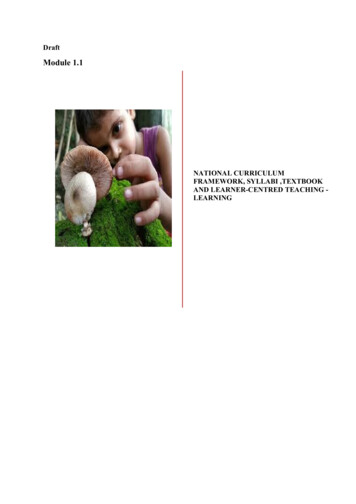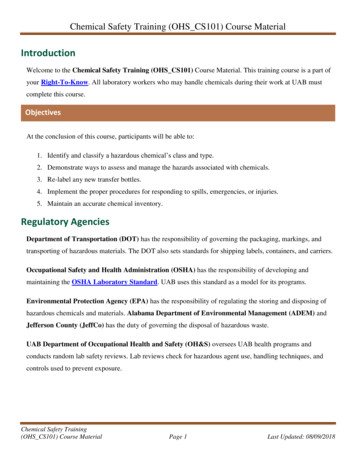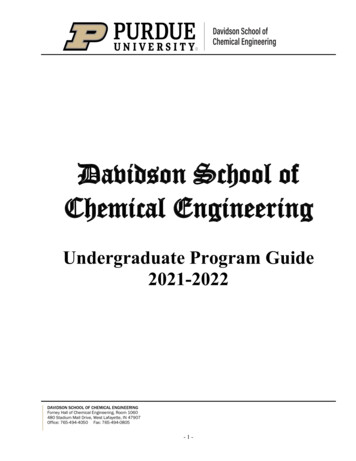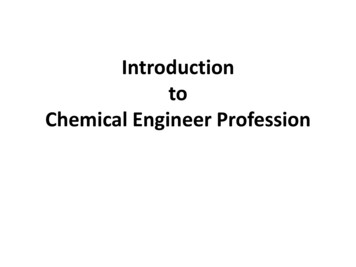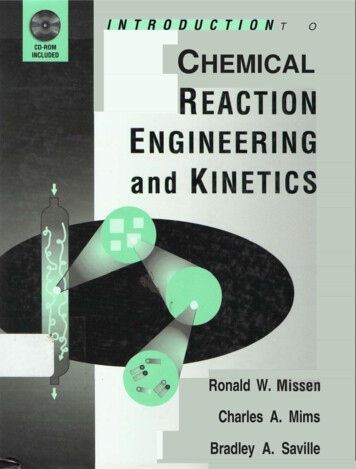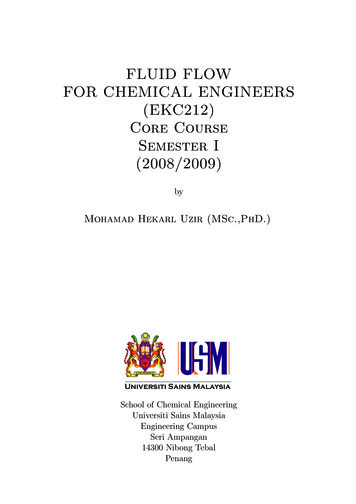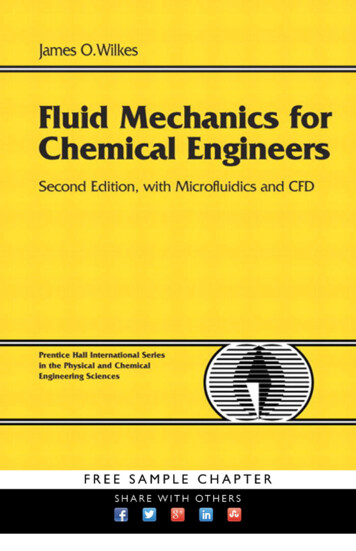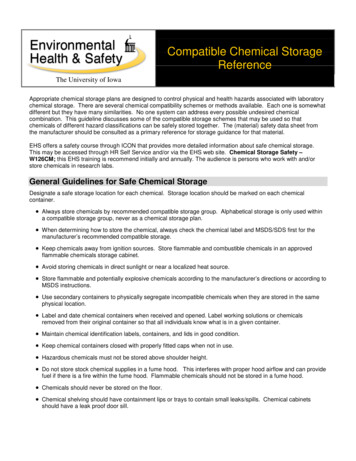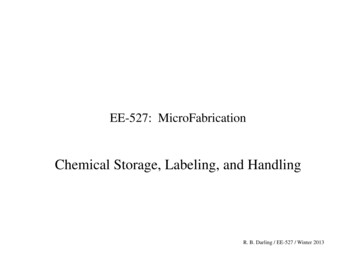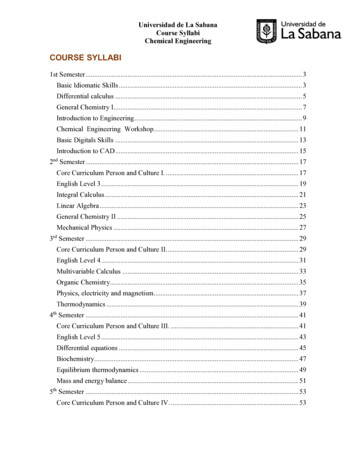
Transcription
Universidad de La SabanaCourse SyllabiChemical EngineeringCOURSE SYLLABI1st Semester . 3Basic Idiomatic Skills . 3Differential calculus . 5General Chemistry I. 7Introduction to Engineering . 9Chemical Engineering Workshop. 11Basic Digitals Skills . 13Introduction to CAD . 152nd Semester . 17Core Curriculum Person and Culture I. . 17English Level 3 . 19Integral Calculus . 21Linear Algebra . 23General Chemistry II . 25Mechanical Physics . 273rd Semester . 29Core Curriculum Person and Culture II. . 29English Level 4 . 31Multivariable Calculus . 33Organic Chemistry. 35Physics, electricity and magnetism . 37Thermodynamics . 394th Semester . 41Core Curriculum Person and Culture III. . 41English Level 5 . 43Differential equations . 45Biochemistry. 47Equilibrium thermodynamics . 49Mass and energy balance . 515th Semester . 53Core Curriculum Person and Culture IV. . 53
Universidad de La SabanaCourse SyllabiChemical EngineeringEnglish Level 6 . 55Chemical Instrumental Analysis . 57Transport Phenomena . 59Materials and Nanomaterials Science. 61Optimization in Chemical Engineering . 63Probability and statistics I. 65Introduction to Administration . 676th Semester . 69Core Curriculum Person and Culture V. . 69English Level 7 . 71Transport Phenomena Engineering . 73Chemical Reaction Engineering . 75Particle Technology and Engineering . 77Economical Engineering. 797th semester . 79Separation Processes and New Technologies . 80Product and Process Design I . 82Biotechnology. 84Entrepreneurship and business creation . 86Grade project seminar . 87Project engineering . 89Introduction to Programming. . 91th8 semester . 93Products and Process Design II . 93Process Control and Dynamics . 95Modelling and Simulation in Chemical Engineering . 97Health, safety and Environment. . 99Internship Seminar. 102th9 semester . 104Professional Internship . 104
Universidad de La SabanaCourse SyllabiChemical Engineering1st Semester1. Course number and nameCatalogue Number: 70020Basic Idiomatic Skills2. Credits and contact hoursCredits: 2 Attendance hours: 3 per week - Autonomous work: 3 per week3. Text book, title, author, and year Creme Phyllis y Mary, Lea R. Escribir en la universidad. Barcelona. Gedisa. 2000. G. de Montes, Zoraida y Montes, Laura. Mapas mentales paso a paso. México:Alfaomega, 2003. Instituto Cervantes. Saber escribir. Bogotá: Aguilar, 2007. Martín Vivaldi, Gonzalo. Curso de redacción: teoría y práctica de la composición ydel estilo. Madrid: Paraninfo, 2000. Nueva gramática de la lengua española. Manual. Bogotá: Espasa, 2010. Ortografía básica de la lengua española. Bogotá: Real Academia Española-Espasa,2012. Perelman, Chaïm y Olbrechts-Tyteca, Lucille. Tratado de la argumentación. LaNueva Retórica. Madrid: Gredos, 1989. Robinson, Ken y Lou Aronica. El elemento. Madrid: DeBolsillo, 2011.4. Specific course informationa. The purpose of this course is train students in the knowledge of the native languageas a basic tool to develop reading, writing and oral skills that will help strengthentheir critical thinking.b. No pre-requisitesc. Required.5. Specific goals for the coursea. Specific outcomes of instructiono Identify university reading as a cognitive process, develop planning strategies foracademic writing and plan and elaborate oral speeches.o Reinforce grammar and spelling of the Spanish language.o Improve the ability to navigate and consult electronic media.o Incorporate skills in the handling of computer tools applied to the reading andwriting processes.o Perform academic activities agreed with the teacher for the development of basiclanguage skills.a. Explicitly indicate which of the student outcomes listed in Criterion 3 or any otheroutcomes are addressed by the course.
Universidad de La SabanaCourse SyllabiChemical Engineeringo (g) An ability to communicate effectively.6. Brief list of topics to be covered1. Reading and knowledge.o Reading as a form of access to knowledge.o Aesthetic reading.o Reader process.o Inferential reading and critical reading.o Reading workshops and practical application of the reading processo Inferential reading workshopo Critical reading workshop2. Writing processo The grammar of the Castilian language: morphology and syntax.o Organization and textual creationo Planning. Elaboration of the draft.o Review and edit. Punctuation use and application signs.o Argumentative writing workshops.o Elaboration of an argumentative text. Critical elucidation of the argumentativetext.3. Assertive communicationo Active listeningo The dialogueo The pragmatics of dialogueo Oral presentationo Workshops of critical listening of academic discourseo Workshops of academic speech. Guidance and oral support of academicdiscourse.
Universidad de La SabanaCourse SyllabiChemical Engineering1. Course number and nameCatalogue Number: 80116Differential calculus2. Credits and contact hoursCredits: 3. Attendance hours: 5 per week. Autonomous work: 4 per week3. Text book, title, author, and year Stewart James. Calculus of a variable, early transcendental. Cengage LearningMéxico. 2012 Thomas George. Calculus of a variable. Pearson Education. Mexico .2010. Piskunov Nikolai. Differential and Integral Calculus. Noriega Publishers Group.México.1993.Supplemental materials Haeussler Ernest. Math for administration and economics. Pearson Prentice Hall.México .2008. Purcell Edwin. Differential and Integral Calculus. Pearson Education. México 2007.4. Specific course informationa. The purpose of this course is to give students the knowledge and fundamentalconcepts of single variable and several skills allowing them to work with theconcepts.b. No prerequisitesc. Required.5. Specific goals for the coursea. Specific outcomes of instructionThis course requires previous knowledge of algebra and trigonometry of high school.Upon completion of this course, students will be able to:o Draw functions of single variable to determine domain, range, asymptotes,growth and/or decay intervals and concavity.o Apply the concepts of average rate, instantaneous average, related rate andoptimization to specific problems and other contexts.b. Explicitly indicate which of the student outcomes listed in Criterion 3 or any otheroutcomes are addressed by the course.(a) An ability to apply knowledge of mathematics, science, and engineering6. Brief list of topics to be covered1. Functions and Models.o Four Ways to represent a Functiono Mathematical Models: A catalog of Essential Functionso New Functions from old Functionso Graphing Calculators and Computers
Universidad de La SabanaCourse SyllabiChemical Engineeringo Exponential Functionso Inverse Functions and Logarithms2. Limits and Derivativeso The Tangent and Velocity Problemso The Limit of a functiono Calculating Limits Using the Limit Lawso The precise Definition of a Limito Continuityo Limits at Infinity; Horizontal Asymptoteso Tangents, Velocities, and other Rates of Changeo Derivativeso The Derivative as a Function3. . Differentiation Ruleso Derivatives of polynomials and Exponential Functionso The Product and Quotient Ruleso Rates of Change in the Natural and Social Scienceso Derivatives of trigonometric Functionso The Chain Ruleo Implicit Differentiationo Higher Derivativeso Derivatives of Logarithmic Functionso Hyperbolic Functionso Related Rateso Linear approximations and Differentials.4. Applications Of Differentiationo Maximum and Minimum Valueso The Mean Value Theoremo Hoe Derivatives Affect the Shape of a Grapho Indeterminate Forms and L Hospital s Ruleo Summary Of Curve Sketchingo Optimization Problems
Universidad de La SabanaCourse SyllabiChemical Engineering1. Course number and name:Catalogue Course Number: 21102General Chemistry I2. Credits and contact hours:Credits: 3, Contact hours: 5, Individual work hours: 43. Text book, title, author, and year BROWN, T., LeMAYT, H.E. y BURSTEN, B., 2004, Chemistry, The CentralScience, 9ª Ed., Ed. Prentice Hall, México. CHANG, R., 2007, Chemistry, 9ª Ed., Ed. Mac Graw Hill, China.Supplemental materials WHITTEN, K., DAVIS, R. y PECK, M., 2008, General Chemistry, 8ª Ed., Ed. MacGraw Hill, Madrid. KOTZ, J.C. y TREICHEL, P.M., 2005, Chemistry and Chemical Reactivity, 6aEdition, Ed. Thomson, México. PETRUCCI, R. y HARWOOD, W., 1999, General Chemistry, 7ª Ed., Ed. Prenticemay Iberia, Madrid. BRICEÑO, C.O. y RODRIGUEZ DE CACERES, L., 1999, Chemistry, 2ª Ed., FondoEducativo Panamericano, Bogotá. EBBING, D.D. y GAMMON S.D. 2010, General Chemistry, 9ª Ed., CengageLearning, México.4. Specific course informationa. One of the professional strengths of an engineer is the panoramic view that allowshim to observe the different factors related to a situation and analyze them criticallyto make adequate and well-argued proposals. The basic scientific basis allows theprofessional to understand the natural environment and brings it closer to scientificand technological development. This subject provides the basis for understanding thephysical behavior of materials; knowing the atomic and molecular structure of mattercan understand the interactions between different particles that cause the differentstates of aggregation of substances and the possibility of mixing with each other.b. No Prerequisitesc. Required5. Specific goals for the course
Universidad de La SabanaCourse SyllabiChemical Engineeringa. Specific outcomes of instruction:o Awaken curiosity and intellectual restlessness for everything that surrounds us.o Develop reading and writing skills (in text, tables and graphs) in the context ofthis science.o Know the basic physical principles that explain the behavior of materials andallow understanding the environment.o Develop ability to relate variables.o Apply, in the topics covered in the program, the mathematical concept ofproportions, developing skills for its management.o Encourage students to develop an abstract thinking, with the ability to relate it toconcrete thinking.o Recognize the dynamism of science and technology, understanding the importantrole of research in its development.o Promote the development of a logical and critical thinking in the analysis andinterpretation of problematic situations and in the proposal of solutions to themwith good arguments.o Create habits that help take responsibility for the study.b. Explicitly indicate which of the student outcomes listed in Criterion 3 or any otheroutcomes are addressed by the course.o a - Applies knowledge of science, mathematics and engineering6. Brief list of topics to be covered Measurements, International System of Units and precision and accuracy ofmeasurements Fundamental concepts on matter and energy Atomic and molecular structures Concept of mol Physical behavior of materials: intermolecular forces Changes in condition: solid, liquid and gaseous Homogeneous mixtures. Solutions and colloids
Universidad de La SabanaCourse SyllabiChemical Engineering1. Course number and nameCatalogue Number: 80062Introduction to Engineering2. Credits and contact hoursCredits: 2. Attendance hours: 2 per week. Autonomous work: 4 per week3. Text book, title, author, and year Thinking like an Engineer: An Active Learning Approach by E. A. Stephan, D. R.Bowman, W. J. Park, B. L. Sill, and M. W. Ohland (Prentice Hall, 2011 /ISBN-13:978-0-13-606442-8Supplemental materials Supplementary course material is available at Virtual Sabana -Online ) for students registered for the course4. Specific course informationa. This course provides an introduction to the engineering profession. Information on thedifferent disciplines of engineering will be presented. Professional and ethical aspectsof engineering are covered. An introduction to problem solving and the engineeringdesign process.b. No Prerequisitesc. Required.5. Specific goals for the coursea. Specific outcomes of instruction.o To prepare students for the rigor of future engineering classeso To provide students with a solid foundation of basic engineering skillso To introduce students to the different engineering majors and career optionsb. Explicitly indicate which of the student outcomes listed in Criterion 3 or any otheroutcomes are addressed by the course.o (c) ability to design a system or component, under realistic constraintso (d) An ability to function on multidisciplinary teams.o (e) An ability to identify, formulate, and solve engineering problems.6. Brief list of topics to be covered Differences between the various fields of engineering specialization.o Identify future career paths and job opportunities as related to the Engineeringprofession. Design Processo How might we create the best possible solution to a problem?
Universidad de La SabanaCourse SyllabiChemical Engineeringoooo What is the most effective way to generate potential solutions to a problem?How many alternate solutions should you generate?What are the most pressing engineering/technical problems of our time?What is an engineer? What types of work do engineers do?Describe the moral foundations of Engineering Ethics.o List some of the basic tenets of the Codes of Engineering Ethics.o Discuss case studies as applied to Engineering.
Universidad de La SabanaCourse SyllabiChemical Engineering1. Course number and nameCatalogue number: 1502101Chemical Engineering Workshop2. Credits and contact hoursCredits: 2. Attendance hours: 2 per week. Autonomous work: 4 per week3. Text book, title, author, and year Basic Principles and Calculations in Chemical Engineering / David MantnerHimmelblau; tr. Roberto Lui Introduction to chemical processes: Principles, analysis, synthesis. Regina M.Murphy, 20074. Specific course informationa. Recognize the importance of scientific knowledge as a basis for solving engineeringproblems. Establish a structured method for solving various problems in ChemicalEngineering. Properly use block diagrams to represent processes in the chemicalindustry. Present adequately the technical reports in which the problem presents, themethod (s) used in its solution, the data, the answers and the conclusions that gaverise to it. Structure a method for the design of processes with chemical reaction.b. No prerequisitesc. Required.5. Specific goals for the coursea. Specific outcomes of instructionThis course requires previous knowledge on basic statistics and operationmanagement. Upon completion of this course, students will be able to function onteams to model systems with stochastic characteristics, then the students will be ableto:o Design experiments: collect, choose and process data, using statistical tools.o Apply the steps of a simulation study.o Build models using specialized software.o Evaluate alternatives and interpret the statistical analysis results to take decisions.b. Explicitly indicate which of the student outcomes listed in Criterion 3 or any otheroutcomes are addressed by the course.o (c) Ability to design a systemo (d) Ability to work in groupso (i) Continuous self-learningo (k) An ability to use the techniques, skills, and modern engineering toolsnecessary for engineering practice.6. Brief list of topics to be covered
Universidad de La SabanaCourse SyllabiChemical Engineering Characterization of the product to be stored. Identification of the physicochemicalproperties necessary to carry out the design of the storage system. Identification ofrisks to health, the environment, and industrial safety. Industrial applications,procurement. Deliverable: Product Description and storage capacity.Location of the plant, Identification of the areas that will make up the storage system.Storage system plans, integration between areas, control systems, administrative,security and logistics.Review the information collected on the storage system and research of industrialprocesses for the chemical synthesis of the assigned compoundEach team will design 3 options to synthesize the assigned compound usingtheoretical bases of inorganic and organic chemistry. For each process they willconstruct the generation matrix - consumptionFrom the selected process, additional tasks will be assigned to increase the processcomplexity until a chemical process involving 2 to 3 chemical reactions is obtained.With this process, students will generate the new consumption generation matrix anddesign the block diagram for that processEach working group will investigate the different types of industrial equipment thatoperate as separators, mixers and reactors, to define what type, based on the physicalstate of their compounds, are useful for their process.Review and simplify process diagrams of each team. Draw of new team members.Feedback on teamwork. delivery schedules of the 3rd courtBeginning of the development of the material balance of each team with the finalblock diagram: Reaction of reaction balances, molecular weight calculations,verification of the purity information of the reagents, definition of the phases in whicheach compound is found in each stream in the diagramFinalization of the material balance of the process performed for fixed conditions ofthe process, by hand
Universidad de La SabanaCourse SyllabiChemical Engineering1. Course number and nameCatalogue number: 120015Basic Digitals Skills2. Credits and contact hoursCredits: 3. Attendance hours: 3 per week. Autonomous work: 6 per week3. Text book, title, author, and year Brillo: así es el sistema operativo de Google para el Internet de las cosas gle-para-el-internet-de-las-cosas Intel. (2014). Internet of Things Video: IoT Explained. Recuperado f-things/videos/what-is-theinternet-of-things.html Universidad de Deusto. (2011). Internet de las Cosas. Recuperado dehttps://www.youtube.com/watch?v 542oTWpKPlE Ministerio de las TIC. (s.f). Ciudades inteligentes. Recuperado tes/#competitividad--convivencia o http://www.eduteka.org/modulos/1/8/2118/1 History Channel. (2014). Robótica, Documental. Recuperado dehttps://www.youtube.com/watch?v 3ZjpMg UzIQ Eduteka. (2014). Bitácora de evaluación. http://www.eduteka.org/glosario/tikiindex.php?page Bit%C3%A1cora de evaluaci%C3%B3nSupplemental materials Cárdenas, M. (2014). Video 1 - Competencias en manejo de información –Mahara. https://www.youtube.com/watch?v UPIF6qkXr08 Cárdenas, M. (2014). Video 2 - Competencias en manejo de información –Mahara. https://www.youtube.com/watch?v UPIF6qkXr084. Specific course informationa. The purpose of this course is to give students the knowledge and fundamentalconcepts that are part of the digital competition proposed by the University.b. No Prerequisitesc. Required5. Specific goals for the coursea. Specific outcomes of instructiono Explains the different elements of knowledge products.o Reuses knowledge products and generates new uses and representations.o Designs, plans and evaluates collaborative work strategies that allow him / herto meet the proposed objectives.o Recognizes when and how to use technology of information andcommunication in academic settings.o Promotes and practices the intellectual property statute guidelines.
Universidad de La SabanaCourse SyllabiChemical Engineeringo Develops an intuitive use of computer tools, and adapts easily to the changesthat occur in them.o Choose the most appropriate technological tools to fulfill the proposedobjectives.b. Explicitly indicate which of the student outcomes listed in Criterion 3 or any otheroutcomes are addressed by the course.o (k) ability to use modern engineering tools6. Brief list of topics to be covered Type of Societies through mental maps. Introduction to the current Trends in technology of information andcommunication. Formulation of good quality questions to guide the search of information. Use of databases. Planning of projects mediated by technology of information and communication. Application of criteria for evaluation of information. APA reference standards. Copyright (CR, CL, CC). Fundamentals of Multimedia, fundamentals of design, color theory andtypography. Reality and Virtual Reality
Universidad de La SabanaCourse SyllabiChemical Engineering1. Course number and nameCatalogue number: 21104Introduction to CAD2. Credits and contact hoursCredits: 2. Working hours: 3. Individual work hours: 33. Text book, title, author, and year Schaum s Outlines Descriptive Geometry; Hawk, M. C.; Mc Graw Hill; New York;1962. Geometría Descriptiva; Wellman, B. L.; Editorial Reverte S. A.; Barcelona; 1987. Aprender AutoCAD 2015 con 100 ejercicios prácticos; Alfa Omega; Barcelona;2015. AutoCAD 2002 Avanazado; Tajadura Zapirain, J.A. y Lopez Fernandez, J.; McGraw Hill; Madrid; 2002. Inventor y su simulación con ejercicios prácticos; Younis, W.; AlfaOmega; México;2013.Supplemental materials Web page Virtual sabana: http://virtual.unisabana.edu.co/course/view.php?id 9390 Blog : https://introduccionalcad.blogspot.com.co/4. Specific course informationb. The purpose of this course is to give the students concepts and technological toolsfor them to be able to make a graphical representation, which is a very importantissue in the communication between engineers.c. No prerequisitesd. Required5. Specific goals for the coursea. Specific outcomes of instruction:o The student will be able to understand and manage the graphical representationsin two and three dimensions.o The students will have the ability to develop their engineering careers with theuse of specialized software in order for them to create any type of representations.o The students will be able to interpret graphical representations in different scales.b. Explicitly indicate which of the student outcomes listed in Criterion 3 or any otheroutcomes are addressed by the course.o (k) An ability to use the techniques, skills, and modern engineering toolsnecessary for engineering practice.6. Brief list of topics to be coveredChapter 1.o Descriptive geometry
Universidad de La SabanaCourse SyllabiChemical Engineeringo Introduction (to geometry and descriptive geometry)o Projection af a pointo Projection of a lineo Projection of a planeo Course, slope, real magnitudeo Intersections (line-plane, plane-plane)o Special projectionso Rotationso Geometric bodiesChapter 2. Introduction to AutoCAD Softwareo Introduction (GUI, keyboard manage, among others)o Object construction (Commands, coordinates, types of lines)o Edition and organization (modifications, colors, layers)o Bounded and dimensions.o 3D RepresentationsChapter 3. Introduction to Autodesk Inventor Professional softwareo Creation of projectso Pieces moduleo Assembly moduleo Presentation moduleo Blueprints moduleo Render moduleo Animation module
Universidad de La SabanaCourse SyllabiChemical Engineering2nd Semester1. Course number and nameCatalogue Number: 578001Core Curriculum Person and Culture I.2. Credits and contact hoursCredits: 2. Attendance hours: 2 per week. Autonomous work: 2 per week3. Text book, title, author, and year Yepes Stork, R., Aranguren Echavarría, J. (2009). Fundamentos de antropologíafilosófica: un ideal de la excelencia humana. 6ª ED. España: Eunsa. ISBN 13:9788431316228 / Cap. 1, págs. 21-27. Bicocca, M. (2011) La persona humana y su formación en Antonio Millán-Puelles.Pamplona: Editorial Eunsa. Cap. 4, págs. 102-113. ISBN: 9788431328238 Sélles Dauder, J. F. (2006) Antropología para inconformes. 3ª ED. España: Rialp.ISBN: 9788432135965 Aristóteles. (2009) Ética a Nicómaco. Madrid: Centro de Estudios Políticos yConstitucionales. ISBN: 9788425909559 Isaacs, D. (2010) La educación de las virtudes humanas. 15ªED. Pamplona: Eunsa.Ediciones Universidad de Navarra. ISBN: 9788431327040 Gaja Jaumeandreu, R. (2015) Bienestar, autoestima y felicidad. Bacelona: PenguinRandom House Grupo Editorial. 6ªED. ISBN: 97884990863234. Specific course informationa. The purpose of this course is e
o Promote the development of a logical and critical thinking in the analysis and interpretation of problematic situations and in the proposal of solutions to them with good arguments. o Create habits that help take responsibility for the study. b. Explicitly indicate which of the student outcomes listed in Criterion 3 or any other

